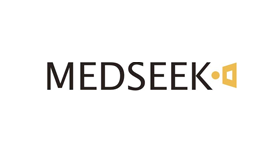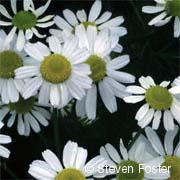German chamomile
Chamomile - German; Matricaria recutita
Chamomile is one of the most popular herbs in the Western world. There are two plants known as chamomile: the more popular German chamomile (Matricaria recutita) and Roman, or English, chamomile (Chamaemelum nobile). Although they belong to different species, they are used to treat the same health problems. Both are used to calm frayed nerves, to treat stomach problems, to relieve muscle spasms, and to treat skin conditions and mild infections.
Chamomile has been used as a medicine for thousands of years, dating back to the ancient Egyptians, Romans, and Greeks. Historically, it has been used to treat many conditions, including:
- Chest colds
- Sore throats
- Abscesses
- Gum inflammation (gingivitis)
- Anxiety
- Insomnia
- Psoriasis
- Acne
- Eczema
- Minor first-degree burns
- Inflammatory bowel disease (ulcerative colitis)
- Stomach ulcers
- Children's conditions such as chickenpox, diaper rash, and colic
Although chamomile is popular, there are not many studies that look at whether it works to treat these conditions. Animal studies have shown that German chamomile reduces inflammation, speeds wound healing, reduces muscle spasms, and serves as a mild sedative to help with sleep. Few studies have investigated whether the same is true in people. Test tube studies have shown that chamomile can kill bacteria, fungus, and viruses.
Anxiety, insomnia
Most people in the U.S. who take chamomile use it to relieve anxiety or help them sleep. So far there has been only one controlled, randomized clinical trial using chamomile to treat anxiety in people. It found that chamomile capsules reduced symptoms of anxiety in people with mild to moderate generalized anxiety disorder (GAD). Animal studies have found that low doses of chamomile may relieve anxiety, while higher doses help sleep.
Digestive problems
Chamomile has been used traditionally to treat stomach cramps, irritable bowel syndrome (IBS), indigestion, diarrhea, gas, and colic. It helps relax muscle contractions, particularly in the smooth muscles that make up the intestines. But there are no good human studies on any of these conditions. One analysis of several studies found that a product with a combination of the herb iberis, peppermint, and chamomile helped relieve symptoms of indigestion.
Gingivitis, mouth sores
Some people use chamomile for these mouth problems, but so far there is no evidence that it works. When used as a mouthwash, there is some evidence that chamomile may help prevent mouth sores from radiation and chemotherapy, but results from studies are mixed.
Skin irritations, eczema
Chamomile is often used in a cream or ointment to soothe irritated skin, especially in Europe. Most evidence comes from animal studies, not studies with people. Two studies in people found that a chamomile cream helped relieve symptoms of eczema.
Plant Description
The tiny daisy-like flowers of German chamomile have white collars circling raised, cone-shaped, yellow centers and are less than an inch wide, growing on long, thin, light green stems. Sometimes chamomile grows wild and close to the ground, but you can also find it bordering herb gardens. It can reach up to 3 feet high. German chamomile is native to Europe, north Africa, and some parts of Asia. It is closely related to Roman chamomile (Chamaemelum nobile), which, although less commonly used, has many of the same medicinal properties.
What is it Made Of?
Chamomile teas, ointments, and extracts all start with the white and yellow flower head. The flower heads may be dried and used in teas or capsules, or crushed and steamed to produce a blue oil, which is used as medicine. The oil contains ingredients that reduce swelling and may stop the growth of bacteria, viruses, and fungi.
Available Forms
German chamomile is available as dried flower heads, tea, liquid extract, capsules, and topical ointment.
How to Take It
Pediatric
Ask your doctor before giving chamomile tea to a child. Children under 5 should not take more than half a cup of tea per day.
To relieve colic: Some doctors suggest 1 to 2 oz. of tea per day. Your doctor may recommend other doses.
Adult
- Tea: Pour 1 cup of boiling water over 2 to 3 heaping tsp. (2 to 4 g) of dried herb, steep 10 to 15 minutes. Drink 3 to 4 times per day between meals.
- Tincture (1:5, 45% alcohol): 30 to 60 drops of tincture, 3 times per day in hot water.
- Capsules: 300 to 400 mg taken 3 times per day.
- Gargle or mouthwash: Make a tea as above, then let it cool. Gargle as often as desired. You may also make an oral rinse with 10 to 15 drops of German chamomile liquid extract in 100 ml warm water, and use 3 times per day.
- Inhalation: Add a few drops of essential oil of chamomile to hot water (or use tea) and breathe in the steam to calm a cough.
- Bath: Use 1/4 lb. of dried flowers per bath, or add 5 to 10 drops of essential oil to a full tub of water to soothe hemorrhoids, cuts, eczema, or insect bites.
- Poultice: Make a paste by mixing powdered herb with water and apply to inflamed skin.
- Cream: Use a cream with a 3 to 10% chamomile content for psoriasis, eczema, or dry and flaky skin.
Precautions
The use of herbs is a time-honored approach to strengthening the body and treating disease. Herbs, however, can interact with other herbs, supplements, or medications. For these reasons, you should take herbs with care, under the supervision of a health care provider.
German chamomile is considered generally safe.
Chamomile may make asthma worse, so people with asthma should not take it.
Pregnant women should avoid chamomile because of the risk of miscarriage.
Chamomile may act like estrogen in the body, so women with a history of hormone-sensitive cancers, such as breast or uterine cancer, should ask their doctors before taking it.
If you are allergic to asters, daisies, chrysanthemums, or ragweed, you may also be allergic to chamomile.
Drinking large amounts of highly concentrated chamomile tea may cause vomiting.
Chamomile may cause drowsiness, so DO NOT take it and drive.
Stop taking chamomile at least 2 weeks before surgery or dental surgery, because of the risk of bleeding.
Possible Interactions
If you take any of the following drugs, you should not use German chamomile without first talking to your health care provider:
Blood-thinning medications (anticoagulants and antiplatelets): Chamomile may increase the risk of bleeding when taken with blood-thinners such as warfarin (Coumadin), clopidogrel (Plavix), and aspirin.
Sedatives: Use caution with sedatives since chamomile can make these drugs stronger, including:
- Anti-seizure medications, such as phenytoin (Dilantin) and valproic acid (Depakote)
- Barbiturates
- Benzodiazepines, such as alprazolam (Xanax) and diazepam (Valium)
- Drugs to treat insomnia, such as zolpidem (Ambien), zaleplon (Sonata), eszopiclone (Lunesta), and ramelteon (Rozerem)
- Tricyclic antidepressants, such as amitriptyline (Elavil)
- Alcohol
The same is true of sedative herbs, such as valerian, kava, and catnip.
Blood pressure medications: Chamomile may lower blood pressure slightly. Taking it with drugs for high blood pressure could cause blood pressure to drop too low.
Diabetes medications: Chamomile may lower blood sugar. Taking it with diabetes drugs could raise the risk of hypoglycemia or low blood sugar.
Hormonal therapies: Due to its similarity to estrogen, chamomile may potentially interfere with drugs such as nolvadex (Tamoxifen) among others.
Other drugs: Because chamomile is broken down by the liver, it may interact with other drugs that are broken down the same way. Those drugs may include:
- Fexofenadine (Seldane)
- Statins (drugs that can lower cholesterol)
- Birth control pills
- Some antifungal drugs
Supporting Research
Ali-Shtayeh MS, Yaniv Z, Mahajna J. Ethnobotanical survey in the Palestinian area: a classification of the healing potential of medicinal plants. J Ethnopharmacol. 2000;73(1-2):221-232.
Amsterdam JD, Shults J, Soeller I, Mao JJ, Rockwell K, Newberg AB. Chamomile (Matricaria recutita) may provide antidepressant activity in anxious, depressed humans: an exploratory study. Altern Ther Health Med. 2012 Sep-Oct;18(5):44-9.
Amsterdam JD, Yimei L, Soeller I, et al. A randomized, double-blind, placebo-controlled trial of oral Matricaria recutita (chamomile) extract therapy for generalized anxiety disorder. J Clin Psychopharmacol. 2009;29(4):378-382.
Avallone R, Zanoli P, Puia G, et al. Pharmacological profile of apigenin, a flavonoid isolated from Matricaria chamomilla. Biochem Pharmacol. 2000;59(11):1387-1394.
Blumenthal M, Goldberg A, Brinckmann J. Herbal Medicine: Expanded Commission E Monographs. Newton, MA: Integrative Medicine Communications; 2000:57-61.
de la Torre Morin F, Sanchez Machin I, Garcia Robaina JC, et al. Clinical cross-reactivity between Artemisia vulgaris and Matricaria chamomilla (chamomile). J Investig Allergol Clin Immunol. 2001;11(2):118-122.
Foti C, Nettis E, Panebianco R, et al. Contact urticaria from Matricaria chamomilla. Contact Dermatitis. 2000;42(6):360-361.
Gyllenhaal C. Efficacy and safety of herbal stimulants and sedatives in sleep disorders. Sleep Med Rev. 2000;4(2).
Heck AM, DeWitt BA, Lukes AL. Potential interactions between alternative therapies and warfarin. Am J Health Syst Pharm. 2000;57(13):1221-1227.
Khayyal MT, el-Ghazaly MA, Kenawy SA, et al. Antiulcerogenic effect of some gastrointestinally acting plant extracts and their combination. Arzneimittelforschung. 2001;51(7):545-553.
Martins MD, Marques MM, Bussadori SK, Martins MA, Pavesi VC, Mesquita-Ferrari RA, Fernandes KP. Comparative analysis between Chamomilla recutita and corticosteroids on wound healing. An in vitro and in vivo study. Phytother Res. 2009 Feb;23(2):274-8.
Mazokopakis EE, Vrentzos GE, Papadakis JA, et al. Wild chamomile (Matricaria recutita L.) mouthwashes in methotrexate-induced oral mucositis. Phytomedicine. 2005 Jan;12(1-2):25-7.
McKay DL, Blumberg JB. A review of the bioactivity and potential health benefits of chamomile tea (Matricaria recutita L.). Phytother Res. [Review]. 2006 Jul;20(7):519-30.
Miller L. Herbal medicinals: selected clinical considerations focusing on known or potential drug-herb interactions. Arch Intern Med. 1998;158(20):2200-2211.
O'Hara M, Kiefer D, Farrell K, et al. A review of 12 commonly used medicinal herbs. Arch Fam Med. 1998:7(6):523-536.
Roberts RE, Allen S, Chang AP, et al. Distinct mechanisms of relaxation to bioactive components from chamomile species in porcine isolated blood vessels. Toxicol Appl Pharmacol. 2013;272(3):797-805.
Singh O, Khanam Z, Misra N, Srivastava MK. Chamomile (Matricaria chamomilla L.): An overview. Pharmacogn Rev. 2011 Jan;5(9):82-95. doi: 10.4103/0973-7847.79103.
Srivastava JK, Shankar E, Gupta S. Chamomile: A herbal medicine of the past with bright future. Mol Med Report. 2010 Nov 1;3(6):895-901.
Subiza J, Subiza JL, Hinojosa M, et al. Anaphylactic reaction after the ingestion of chamomile tea: a study of cross-reactivity with other composite pollens. J Allergy Clin Immunol. 1989;84(3):353-358.
Viola H, Wasowski C, Levi de Stein M, et al. Apigenin, a component of Matricaria recutita flowers, is a central benzodiazepine receptors-ligand with anxiolytic effects. Planta Med. 1995;61(3):213-216.
Zick SM, Wright BD, Sen A, Arnedt JT. Preliminary examination of the efficacy and safety of a standardized chamomile extract for chronic primary insomnia: a randomized placebo-controlled pilot study. BMC Complement Altern Med. 2011 Sep 22;11:78. doi: 10.1186/1472-6882-11-78.

Review Date: 3/25/2015
Reviewed By: Steven D. Ehrlich, NMD, Solutions Acupuncture, a private practice specializing in complementary and alternative medicine, Phoenix, AZ. Review provided by VeriMed Healthcare Network.

